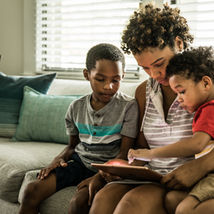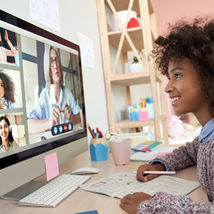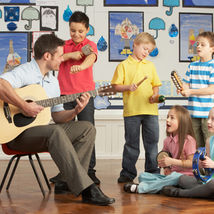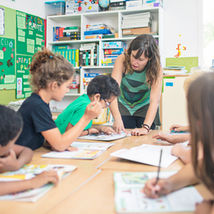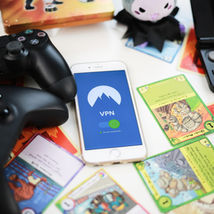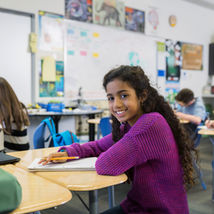9 Ways to Make Social Media Safer for Children

As parents, our two top priorities are to keep our children safe and to provide as many opportunities as possible for them to make the most of their lives.
However, we also know that it can be challenging to do both at once; allowing our children to experience life often comes at the cost of having to expose them to dangers and threats from which they were previously sheltered.
Of course, trying to keep children from the world certainly won’t work, and is neither practical nor responsible parenting. It’s much better to provide them with guidance and equip them with knowledge so that they can navigate this crazy, exciting world in a safe and meaningful way.
There is perhaps no better example of the challenge in finding this balance than social media. Both a rich resource and a hotbed for fraud or worse, it’s essential that we do everything we can to make social media – which is not inherently dangerous – safer and more constructive for kids to use.
The Perks of Social Media for Children
At first glance, some people are quick to say, “children don’t belong on social media.” And while there is some merit to this argument, it’s simply not practical to take this approach. Recent research from Pew found that 95 percent of kids – particularly teenagers between the ages of 13 and 17 – have access to the internet, with just over 50 percent of respondents saying they are “constantly” online.
It doesn’t help that most social media platforms only require you to be 13 (Facebook) or 16 (Snapchat) to join, meaning you’re fighting an uphill battle to keep them from these platforms.
Plus, when used properly, social media can provide significant benefits to your children, such as:

These benefits, along with the inevitability of your child’s social media use, advocate that we should be realistic and embrace that kids are going to use social media. This perspective will allow us to develop more proactive and effective methods of keeping them safe.
The Dangers of Social Media to Children
Of course, all of these positive aspects of social media do not remove the genuine dangers these platforms can expose our children to when they use them. Some of the most common threats kids face are:

Complied into one list, these threats make it seem like social media is a playground for all sorts of loathsome people. While we must admit they’re out there, we must also recognize they do not define the social media landscape. Good habits, combined with the right practices, can easily keep your kids from running into any of these unsavory individuals.
9 Ways to Keep Kids Safe on Social Media
Now that we understand the approach we need to take to keep kids safe when they’re using social media, here are nine techniques that will help you insulate your kids from the dangers of social media while allowing them to make use of its many benefits.
1. Learn How they Use Social Media (or Why They Want To)
The first step in keeping your kids safe is to learn about the environment in which they’re operating, which involves two things.
The first is directly asking your kids what they use, what their friends are using, or what they would like to be using. There are so many different platforms out there, and new ones are popping up all the time, that it’s much better to go straight to the source.
If and when they mention a platform you’re not familiar with, ask your child to show you what it is. Expressing genuine interest and encouraging them to teach you how to use it properly will often lead to them being more forthcoming than if they perceive you to be “grilling” them.
Should you see something concerning, feel free to ask more, but in the early stages, it’s more about showing them they’re speaking in a safe environment so that they will feel safe about openly sharing.
2. Educate Yourself on the Platforms that are Out There
Once you’ve begun the dialogue with your child or children, it’s important you then do your own research about the apps they are using as well as some of the others that are out there. We all want to think our kids will tell us everything, but the reality is they could have omitted information on purpose to hide any activity they know you would disapprove of.
In addition to the apps your children mention to you, you should also consider looking into any of the following platforms you’re not familiar with:

Other things you will want to look out for are apps designed to conceal other apps. It’s obviously not ideal to be snooping around your kids’ phones, but if you hear them talking about or see them using one of these apps, know that it might be time to discuss what your kids are doing online.
3. Set Privacy Settings
While it’s true that social media exposes users to other people, social media networks, over the years, have expanded the level of control we have over our own privacy, therefore reducing our risk and making social media safer.
The primary way they have done this is by offering personalized privacy settings. When your kid starts using social media, make sure they understand what these are and that they are set to the “most private” or “most secure.”
This will set it so that anything on your kid’s profile or anything they share will not be exposed to anyone outside of their network. Of course, it then becomes important to keep an eye on who’s in your kids’ networks, but this is something that should be a part of the many discussions on this issue so that your children learn to be selective about the people with whom they choose to connect.
One thing to remember, though, is that you make it clear to your kids that there is a difference between “private on the internet” and “private in real life.” Even with the tightest controls, posting something to the internet is still putting something out there, and once stuff is out there, it doesn’t come back.
4. Establish Ground Rules for the Entire Family
Our goal is to help kids use social media to provide them with a degree of independence and autonomy while also not exposing them to excessive risk. One good way to do this is to establish clear ground rules that everyone in the house will follow.
This part about everyone is particularly crucial because it demonstrates to kids that it’s not just them being subjected to regulation. Everyone is buying in because it’s simply the right thing to do.
As a result of this, it’s also essential that the conversation about the ground rules involves everyone. Including your child’s views and perspectives into the decision will help them see that you’re acting in their best interest and should make it easier to enforce the guidelines you’re creating.
Each family will have slightly different rules, but some good ones to include are:

Having family guidelines works best if you turn this into a discussion! CyberWise makes this easy for you by outlining topics to discuss and agree to in the downloadable "Parent/Child Tech Agreement." Establishing something like this, and then discussing it frequently to keep it fresh in people’s minds is important. Making sure everyone is following along can help create at the very least clarity about social media use in the house, making it much easier for kids to follow the rules set out to keep them safe.
5. Provide Your Child With Ownership Over Their Security
We’ve hinted at this by mentioning the importance of including kids in the conversations you have about social media in the home, but we also thought it deserved its own point.
The idea is to get kids involved, so they see this issue as something that’s also important for them. One way to do this is to encourage kids to get on a schedule of regularly changing their passwords. A simple thing like this helps keep security in their minds while also putting them in control, which is much more likely to make your system work.
In the end, the more they feel what they are doing is for their own benefit, the better you will be at convincing your kids to adopt good habits and follow the rules when they use social media.
6. Use Parental Controls When Needed
We don’t want it to come to this, but you as parents, and also your children, do need to remember where the power remains. Kids, often in an attempt to exert their self-identity, love to rebel against any rules imposed upon them, even if they are put in place with their best interests in mind. But they need to know there are consequences, especially when it comes to social media.
Make it clear that failure to comply with the ground rules laid out will result in loss of privileges and potentially the implementation of parental controls. You can do things such as limit a user’s ability to share on social media, access the internet, visit specific sites, and more, which will surely put an end to risky behavior.
Again, we don’t want it to get to this as this type of action erodes trust, but kids need to be completely clear that you’re serious about keeping them safe, even if it means making unpopular decisions.
7. Look for Signs of Distress or Concerning Behavior
Monitor your children as you normally would, but as they start to use social media, keep an eye out for specific behaviors.
Kids having a bad experience online may start to become more withdrawn or secretive about their online use. You may see habits begin to change, or a sudden loss of interest in things that were previously important. If you spot these signs, try to find out what is happening and don’t be afraid to steer the conversation to what’s happening on social media to get them to open up.
Another thing to look out for is excessive screen time. Social media can be addictive, and it can quickly turn into something rather unhealthy. Setting strict screen time limits can sometimes backfire, but if you find your kid is on his or her device way too often, it may be best to get them detached from social media to avoid overuse, which exposes them to even more risk.
8. Explain What You’re Doing
Integral to all of this is an open and honest dialogue with your children about social media. This needs to be grounded with a justification of what you are doing. Parents don’t always need to explain what they are doing with their kids, but this isn’t one of those times.
A key reason for this is that social media is just so popular. It’s only a matter of time before they are the only one not using a particular platform, which will eventually force them to use it in secret and raise the stakes.
It’s much better to be clear what the dangers are, so when they do get on a new platform, they can take steps to make sure they are not putting themselves in harm’s way.
9. Set a Good Example
Lastly, as a parent, it’s essential you take the lead and set a positive example for your kids to follow. Saying one thing and then doing another will, in this case, downplay the sense of threat your kids feel, which will cause them to let their guard down and expose themselves to what’s out there.
This is why it’s so important to educate yourself and then establish guidelines you can also follow. Seeing their parents do the right thing without feeling restricted is the best way to encourage good habits.
Constantly Revisit the Situation
The world of social media is constantly changing. New platforms arise out of nowhere and become all the rage before anyone who’s not a part of the movement has a chance to learn what’s happening. This is when the risks are the highest; it’s an unknown environment.
However, if you’ve worked to approach the issue of social media with your kids by following the steps we’ve outlined here, you can rest easy knowing that your kids will be prepared and will respond the right way.
In the end, the shape-shifting nature of social media means you need to remain vigilant so you can find new threats when they emerge. Talk with your kids, and come up with a plan that works for everyone and makes safety the top priority.
This article was originally published by InfinityDish, and was shared here with permission.
For more articles like this one, timely advice, and tips for digital parents, sign up for our bi-weekly newsletter.


